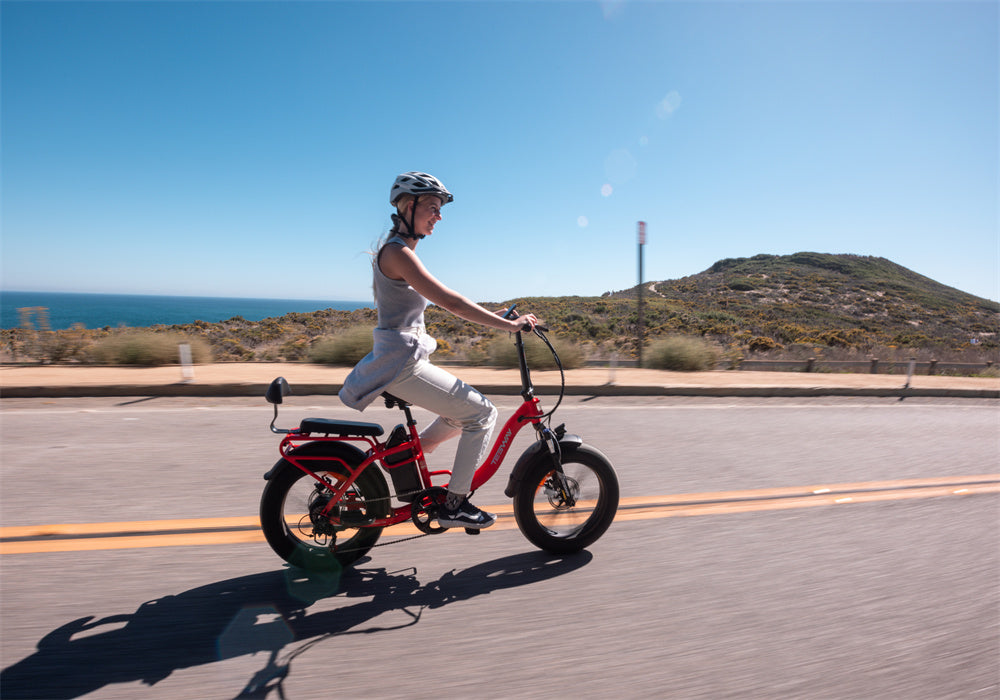Most electric bikes are restricted to a maximum speed of 15 or 20 mph, even though a well-trained cyclist can pedal much faster.
Safety Concerns
The primary reason for the speed limitations on eBikes is safety. Higher speeds increase the risk of accidents, which can lead to severe injuries or fatalities. At speeds exceeding 20 mph, the potential for harm in the event of a collision or fall rises significantly. eBikes are typically used in urban environments, where they share roads with cars, pedestrians, and other cyclists. The risk of accidents at higher speeds is substantial, given the unpredictable nature of traffic in these areas.
Experienced cyclists have developed skills over time that allow them to handle high speeds safely. These skills include advanced bike handling, braking, cornering, situational awareness, and equipment maintenance. An eBike, however, grants the power and speed of a seasoned athlete to a novice rider immediately, without the gradual acquisition of these critical skills. This disparity between power and experience can be dangerous, especially in traffic conditions.

Legal Regulations
In many countries, including the United States, there are strict laws governing the operation of eBikes. These regulations are in place to differentiate eBikes from other motorized vehicles. According to U.S. federal law, for an eBike to be classified as a bicycle and not a motor vehicle, it must not exceed 20 mph on motor power alone. This classification exempts eBikes from stringent licensing, insurance, and registration requirements, making them more accessible to the general public. Speed limitations help maintain this classification and ensure compliance with the law.

Technical Limitations
The technical limitations of eBikes also play a role in speed restrictions. Most eBikes are designed with motors and batteries optimized for efficiency and range rather than high speed. Pushing an eBike beyond 20 mph places additional strain on the motor and battery, leading to faster depletion and reduced overall performance. Manufacturers design eBikes to balance speed, range, and longevity, ensuring that users can enjoy reliable performance over longer distances without frequent recharges. High-speed operation would compromise these aspects, making eBikes less practical for everyday use.

Environmental Considerations
Speed limits on eBikes also contribute to environmental sustainability. Higher speeds typically require more power, which leads to increased energy consumption. By capping the speed at 15 or 20 mph, eBikes can operate more efficiently, using less energy per mile traveled. This efficiency is crucial for reducing the overall carbon footprint of transportation. eBikes are marketed as an eco-friendly alternative to cars, and maintaining energy efficiency helps them fulfill this promise.

User Experience and Control
At higher speeds, the dynamics of riding an eBike change significantly. Steering becomes more sensitive, braking distances increase, and the overall handling can become more challenging. For many users, especially those new to cycling or eBikes, these changes can be intimidating and potentially dangerous. Speed limits help ensure that eBikes remain easy to handle and enjoyable for a wide range of riders, from beginners to experienced cyclists.

Impact on Infrastructure
The impact on infrastructure is another consideration. Urban and suburban areas often have infrastructure designed for traditional bicycles and pedestrians. Introducing high-speed eBikes into these environments could strain existing infrastructure, leading to potential conflicts and safety hazards. By limiting the speed of eBikes, municipalities can better integrate them into current transportation systems without the need for extensive modifications or new regulations.

Promoting Physical Activity
Promoting physical activity is an additional benefit of speed limitations. While eBikes provide motor assistance, many models require the rider to pedal to engage the motor. Speed limits encourage riders to pedal more actively, contributing to physical exercise and overall health. This balance between motor assistance and physical exertion makes eBikes an attractive option for those looking to incorporate moderate exercise into their daily routines.
Public Perception and Acceptance
Public perception and acceptance of eBikes are also influenced by speed regulations. High-speed eBikes could be perceived as dangerous or a nuisance, potentially leading to public backlash and stricter regulations. By keeping speeds within a reasonable range, eBikes can be more widely accepted and integrated into communities as a safe and practical mode of transportation. This acceptance is crucial for the long-term success and growth of the eBike market.
Insurance and Liability
Insurance and liability issues are simplified with speed-limited eBikes. Higher speeds increase the likelihood of accidents, which can complicate insurance claims and liability determinations. By capping speeds at 15 or 20 mph, the risks are minimized, making it easier for insurers to provide coverage and for riders to navigate the legal landscape in the event of an accident.
Conclusion
While it may seem counterintuitive that eBikes are capped at speeds that a strong cyclist can exceed, these restrictions ensure that eBikes remain safe, practical, and accessible to a wide audience. Buy the best budget ebike at Tesway!
FAQs
Can I modify my eBike to go faster than 20 mph?
While it is technically possible to modify an eBike to exceed 20 mph, doing so may void warranties, violate local laws, and increase the risk of accidents.
Why are speed limits different in various countries?
Speed limits vary based on local regulations, safety standards, and infrastructure considerations unique to each region.
Are there any eBikes that can legally go faster than 20 mph?
Yes, certain classes of eBikes, such as Class 3 eBikes, can legally assist up to 28 mph, but they are subject to different regulations and often require additional safety features.







Share:
Tired of Cycling Knee Pain? Try These Fixes
The Comprehensive Health Benefits of Cycling